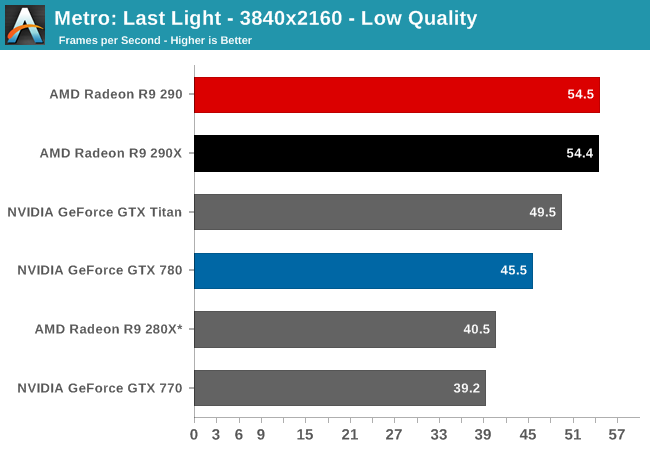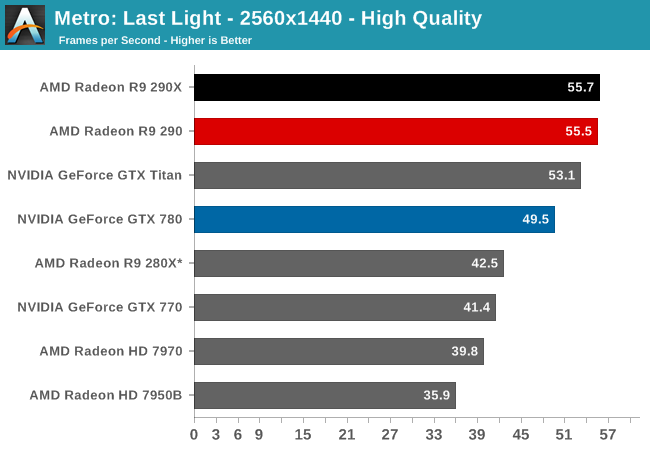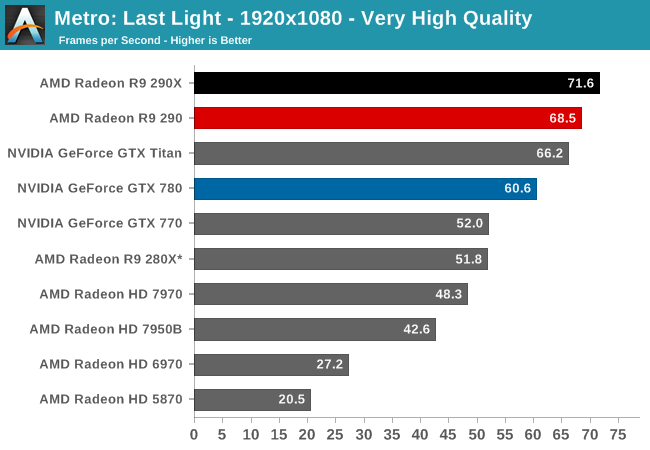The AMD Radeon R9 290 Review
by Ryan Smith on November 5, 2013 12:01 AM EST- Posted in
- GPUs
- AMD
- Radeon
- Hawaii
- Radeon 200
Metro: Last Light
As always, kicking off our look at performance is 4A Games’ latest entry in their Metro series of subterranean shooters, Metro: Last Light. The original Metro: 2033 was a graphically punishing game for its time and Metro: Last Light is in its own right too. On the other hand it scales well with resolution and quality settings, so it’s still playable on lower end hardware.



For the bulk of our analysis we’re going to be focusing on our 2560x1440 results, as monitors at this resolution will be what we expect the 290 to be primarily used with. A single 290 may have the horsepower to drive 4K in at least some situations, but given the current costs of 4K monitors that’s going to be a much different usage scenario. The significant quality tradeoff for making 4K playable on a single card means that it makes far more sense to double up on GPUs, given the fact that even a pair of 290Xs would still be a fraction of the cost of a 4K, 60Hz monitor.
With that said, there are a couple of things that should be immediately obvious when looking at the performance of the 290.
- It’s incredibly fast for the price.
- Its performance is at times extremely close to the 290X
To get right to the point, because of AMD’s fan speed modification the 290 doesn’t throttle in any of our games, not even Metro or Crysis 3. The 290X in comparison sees significant throttling in both of those games, and as a result once fully warmed up the 290X is operating at clockspeeds well below its 1000MHz boost clock, or even the 290’s 947MHz boost clock. As a result rather than having a 5% clockspeed deficit as the official specs for these cards would indicate, the 290 for all intents and purposes clocks higher than the 290X. Which means that its clockspeed advantage is now offsetting the loss of shader/texturing performance due to the CU reduction, while providing a clockspeed greater than the 290X for the equally configured front-end and back-end. In practice this means that 290 has over 100% of 290X’s ROP/geometry performance, 100% of the memory bandwidth, and at least 91% of the shading performance.
So in games where we’re not significantly shader bound, and Metro at 2560 appears to be one such case, the 290 can trade blows with the 290X despite its inherent disadvantage. Now as we’ll see this is not going to be the case in every game, as not every game GPU bound in the same manner and not every game throttles on the 290X by the same degree, but it sets up a very interesting performance scenario. By pushing the 290 this hard, and by throwing any noise considerations out the window, AMD has created a card that can not only threaten the GTX 780, but can threaten the 290X too. As we’ll see by the end of our benchmarks, the 290 is only going to trail the 290X by an average of 3% at 2560x1440.
Anyhow, looking at Metro it’s a very strong start for the 290. At 55.5fps it’s essentially tied with the 290X and 12% ahead of the GTX 780. Or to make a comparison against the cards it’s actually priced closer to, the 290 is 34% faster than the GTX 770 and 31% faster than the 280X. AMD’s performance advantage will come crashing down once we revisit the power and noise aspects of the card, but looking at raw performance it’s going to look very good for the 290.










295 Comments
View All Comments
kwrzesien - Tuesday, November 5, 2013 - link
I would agree with you if the 280X was actually a re-spin of the Tahiti silicon and included TrueAudio and whatever other IP and low-level changes come with the Hawaii die, just with Tahiti configuration and speed. Unfortunately it's not, and is already out of date.I was hoping that the 290 would be the perfect solution with all the newest features but cut down to reasonable power/temp/noise limits - but that is not to be. Maybe they need a 290L.
cactusdog - Tuesday, November 5, 2013 - link
I thought most people bought custom cooler highend cards these days anyway, unless you're on water. The reference cards don't seem to last very long, if you look on newegg for current cards like NVidia 7 series and AMD 7970 etc, most cards on sale are non-reference models. For some models you cant find a reference model. Personally, I haven't bought a reference blower cooler for a couple of generations, even the "quiet" versions are much louder than a good non reference cooler like Twin frosr, Asus DCUII or Sapphire Toxic and Giga Windforce.Braincruser - Tuesday, November 5, 2013 - link
nVidia is in no trouble, even if it doesn't sell a single card anymore, all it has to do is move to making hearing aids.Conduit - Tuesday, November 5, 2013 - link
Anandtech showing it's ignorance as usual. This is THE high end card to get right now, who cares if it's loud? Most people game with headsets so won't even hear it in game.Homeles - Tuesday, November 5, 2013 - link
"it's ignorance"Lol. A bit of a hypocrite, are we?
Da W - Tuesday, November 5, 2013 - link
Dear ASUS, MSI, XFX, HSI and others.I usually purchase AMD to help them stay alive.
You have until Christmas to come up with a 290X card using a Nvidia 780 style cooler, or even a water cooler unit by default.
Else i will make due with a GTX 780 and their better bundle of game.
Conduit - Tuesday, November 5, 2013 - link
Don't worry lol, there is still 7 weeks to go until Christmas, if they can't get out custom cooled cards by then then they deserve to get bankrupt.ruthan - Tuesday, November 5, 2013 - link
I personally prefer fanless solution, but if you need performance, i cant use it.. But those cards, are abomination of the week.We need performance gained by better effectivity, not by add other 50Watss power and vacuum cleaner fan inside.
I think that resonable power consumation limit is around 150W, this could be cooled, by big passive cooler and 2-1000 RPM Noctua or others quit fans.
coldpower27 - Wednesday, November 6, 2013 - link
I wish we could just stick to 150W but with this many transistors of computing it just isn't possible. Your probably won't get this level of performance at 150W till next generation.piroroadkill - Tuesday, November 5, 2013 - link
Dear AMD,Please either:
a) make sure you launch with the option of blower AND open quiet cooler
b) make sure you launch with partner custom cards
c) give up making blowers
These cards clearly have headroom and are incredible value. Don't give people a reason to moan about them.